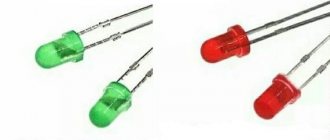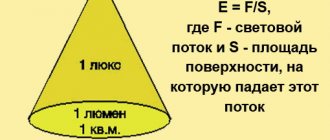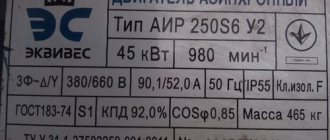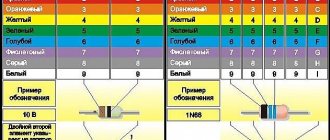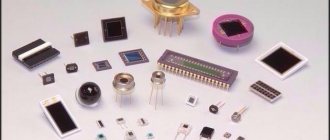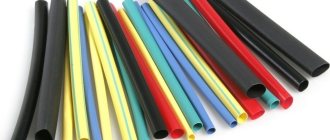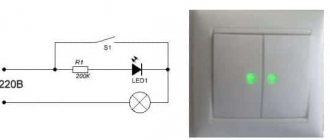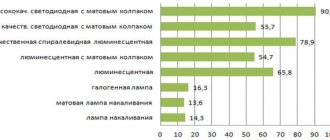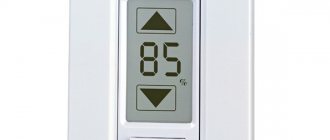Despite the existing myths about LED lamps, their number in residential premises, factories, shops and other buildings is growing rapidly. Conventional incandescent lamps do not meet modern criteria for efficiency and economy; they are gradually being replaced by LED models, which are characterized by a long service life, reasonable price and other advantages, are lightweight, are available in a wide range of sizes, and consist of a glass bulb with a light source and a base. Such lamps practically do not heat up. Every year new types of lamps appear, the technical characteristics of which become more advanced. A real breakthrough was the emergence of Crystal Ceramic MCOB technology.
There are lamps from different manufacturers on the market, which differ significantly in cost, size, power, shape and design features, so it is often difficult for buyers to make a choice, purchase high-quality lamps from well-known manufacturers at the current price and take into account all the necessary parameters. The most popular products are the following brands:
- Eurolamp;
- Osram;
- Philips,
- Biom.
We recommend the product Lamp Biom Led BT-541
In stock
Luminous flux, lm.: 450 | Power, W: 4 | Base: G5.3, GU5.3 |
Products from advertised manufacturers do not always meet quality and safety standards. Without taking many parameters into account, you can purchase a high-quality, powerful lamp from a well-known manufacturer, which is appropriate in the office, but will not create a cozy atmosphere in the bedroom.
Vencon engineering solutions expert has prepared the characteristics of LED lamps that you need to consider when purchasing them.
What affects the power of LED lamps and how to choose the right one
An important parameter characterizing LED lighting equipment is power. This value determines the amount of energy consumed. Therefore, it is not decisive when choosing equipment.
Before choosing a model that is suitable for power, you need to know the following:
- on average, an LED lamp consumes 10 times less than a conventional incandescent light bulb;
- the 1:10 formula is a little crafty, since a 6 W LED bulb is inferior in terms of lighting quality to a 60 W incandescent lamp (certain energy is spent on heat removal);
- The brightness of the lighting is dimmed by 20-30% due to the matte bulb.
Thus, if you want to replace a 60 W incandescent light bulb, then it is recommended to choose an 8 W LED analogue. This will be approximately an equal exchange.
However, LED light sources of equal power may differ in brightness. What is important is not the power equivalent itself, but the luminous flux produced by the lamp. It is by focusing on this indicator that you can select the optimal equipment for each room to ensure the required level of lighting.
Light sources are intended for household use, the power consumption of which varies between 1-10 W. For use in open spaces, there is also more powerful LED lighting equipment, the power of which can reach 100 W.
What is LED brightness and how is it measured?
The brightness of the glow is an indicator of light equal to the ratio of the strength of the luminous flux to the cosine of the angle at which it is emitted and the illuminated area. Another definition is the illumination at a point perpendicular to the source, to the angle in which the beam is enclosed. The brightness of the glow is designated by the letter “L”, measured in millicandelas per meter to the minus second power (cd*m-2). Conventional LEDs have a brightness of 20-50 mcd, while super-bright LEDs have a brightness of up to 20,000 mcd. The perception of objects through human eyes depends on this indicator.
If we talk about LEDs, then their brightness is the power (strength) of light, measured in watts and depending on the angle of the cone, the base of which is located on the illuminated area, the top - in the light source. With equal radiation in all directions, the brightness of the glow will be the ratio of the flux to the spatial angle (in degrees). Most often, degrees are converted to steradians: sr = 2 π (1 – cos θ/2), where θ is the beam angle.
Luminous flux of the Ice lamp
Luminous flux refers to the brightness of the lamp, that is, the amount of light that can be obtained with its help. Each buyer can, guided by his own feelings, say how the new lamp shines: bright or dim, but there is an indicator for measuring the luminous flux, which is determined in lumens.
This value is calculated by multiplying the area of a certain room by the standard of illumination, which you need to choose yourself, and an adjustment for the height of the ceilings. The product of these three indicators will allow you to estimate the total luminous flux that needs to be created using LED equipment.
Illumination standards are defined in regulatory documents. For example, for residential premises near kitchens this figure is 150 Lx, for bathrooms 50 Lx, for children's rooms 200 Lx, for ordinary offices, studies and libraries 300 Lx. If drawing work is being carried out in the office, then the illumination level should be at least 500 Lux.
Many manufacturers have tried to simplify the process of selecting LED equipment. They do not indicate on the packaging the luminous flux indicator, but the equivalence of a traditional incandescent lamp with a certain power. Therefore, it is not difficult for the consumer to decide how many and what types of light bulbs to choose for each specific room.
Sometimes it happens that the optimal power is selected, but the brightness is not satisfactory. This is a common thing: about 90% of factories and almost all Chinese firms that operate in the low-cost segment write false indicators. It’s easy to avoid this problem: take products from major global brands or from companies that sell products in the mid-price category and above (for example, from Philips or Eurolamp).
Additional options to consider when choosing
In addition to the criteria outlined above, which are recommended to be taken into account when choosing light bulbs, it is important to take into account other indicators:
- The packaging is full of information. If there is little information about the product on the packaging material, the product will most likely not be able to guarantee high quality.
- Appearance of the product – no gaps, uneven or rough surfaces are allowed.
- Possibility of changing color during operation. New technologies make it possible to produce luminous flux emission sources that have the function of changing the color palette. It is quite natural that the pricing policy for such products is much higher than for ordinary LED lighting sources.
Color temperature indicator: which is better
LED bulbs can produce a beam of bright yellow color, creating a cool or warm glow. When choosing the color of radiation from lighting equipment, buyers rely mainly on their own taste, striving to provide the most comfortable conditions for work or leisure, but there is a parameter that allows you to wisely select and purchase lamps based on the level of color temperature. This parameter is measured in units such as Kelvin.
In total, there are 3 options for lamps with the following parameters:
- warm light (up to 3500K);
- neutral (3500K-4500K);
- cold (from 4500K).
The higher the indicator, the colder the light. And the greater the glow in the blue spectrum, which is unpleasant for us, which with constant exposure negatively affects vision. And the lens of the eye in children is even more vulnerable to it, so light bulbs with cold light are categorically not welcome in the nursery.
Incandescent lamps produce a pleasant, warm yellow light that ranges from approximately 2800K to 3500K. Most LED light sources have a color temperature above 3500 K and provide soft white light rather than yellow. It does not hurt the eyes, provides excellent visibility, and can be a rational choice for use at home and in the office. The shade of light does not affect the efficiency of the LED lamp; uniform illumination of residential, office space or production areas is possible using lighting equipment of any emission color.
We recommend the product
Osram Star P40 E14 lamp
In stock
Luminous flux, lm.: 470 | Power, W: 6 | Base: E14 |
Lamps with increased light temperatures shine in a neutral white color. Experts recommend purchasing such light sources to organize lighting in offices and reception areas. The white light of the equipment increases productivity and allows you to effectively solve production problems at any time, and the yellow glow provides the opportunity to relax, helps you relax and relieve tension in the living room in front of the TV screen or in a cozy bedroom. White light activates thought processes at any time of the day and sets you up for hard work.
The presence of blue light in the lighting spectrum is not always appropriate. But at night, equipment with such a spectrum negatively affects the human body. There is an opinion that blue spectrum lamps can damage the immature lenses of the eyes, so such light sources are not recommended for installation in children's rooms.
For installation in warehouses, production and utility rooms, light sources with a color temperature of 5000 Kelvin and above are an excellent choice.
Color spectrum
This characteristic refers to how warm the lighting tone will be. Otherwise, this criterion is usually called color temperature, which is measured in degrees Kelvin (K). The higher the number, the colder the color spectrum:
- 2700-2800 - warm yellow
- 3000 - warm white
- 3500 - regular white
- 6500 - cool white
It is believed that natural white light is conducive to work - it increases efficiency. But warm yellow, on the contrary, helps to relax and tunes the brain to rest. Too cold a shade causes tension, so it is not recommended for use in rooms where people spend a long time.
| Colorful temperature | Hue | Characteristics and scope |
| 2700 K | Warm white with a reddish tint | This light is emitted by incandescent lamps of not very high power. Feeling of warmth and comfort. |
| 3000 K | Warm white with a yellowish tint | Characteristic of halogen lamps, the light is slightly cooler. |
| 3500 K | Regular white or neutral white | Characteristic of fluorescent lamps. Neutral light that does not distort color perception. |
| 4000 K | Cold white | Used in some modern styles - high-tech, for example. It can tire you with its “sterility”. |
| 5000-6000 K | Daylight | Used for lighting greenhouses. Too bright for home lighting. |
| 6500 K | Cold daytime, has a bluish tint | Very bright. Used for photo and video shooting. |
Voltage indicator
The voltage indicator is important when choosing a light source. Modern equipment shines brightly and evenly, regardless of voltage drops, thanks to the presence of drivers with a stabilization function in the design. Even with sudden voltage surges of several tens of volts, high-quality light sources will shine evenly and not fail under such unfavorable circumstances.
LED lamps are created by modern manufacturers with different types of bases, which differ in diameter and other parameters. This allows you to purchase this reliable and economical equipment for each room.
The level of uniformity in the distribution of color segments is determined by the color rendering index. This index greatly affects the quality of lighting. It determines how correctly the lamp conveys the shades of the illuminated objects. It is designated by the symbols “Ra” and a number on a 100-point scale (the more, the better). Thus, light bulbs with an index of up to 80Ra can greatly distort the color of objects. Sometimes they merge different shades into one, which makes them unsuitable for homes and offices.
Sometimes manufacturers specify the index using a class. There are 4 of them in total:
- class 1A – 90-100Ra;
- 1B – 80-89Ra;
- 2A – 70-79Ra.
The fourth class is only suitable for street lighting. The index can also be written as a 3-digit number. For example, the number 927 says that the index is 90Ra, and the color temperature is 2700K.
If the indicator is greatly underestimated, color shades are less distinguishable. Lamps with a low color rendering index shine worse and hurt your eyes. Even if there are voltage drops in the network, you should not refuse to purchase LED light sources. Such equipment, despite difficult conditions, will function effectively, creating the proper level of illumination in the space.
We recommend the product
Lamp Biom Led BT-563 G45 6W E27 3000K matte
In stock
Luminous flux, lm.: 650 | Power, W: 7 | Base: E27 |
How to choose LED lamps for your home: comparative analysis of light sources
The high cost of LED light sources often causes doubts about the advisability of using LED lighting. You can figure this out by performing a comparative analysis of an LED lamp and an incandescent lamp. Correspondence tables for various lamp characteristics give an idea of the return on investment of LED devices.
LED lamp wiring diagram
Types of LED lamp bases
For ease of use of LED products in a home network, devices are available with various options for standard sockets. This allows you to effortlessly replace old lamps with modern LED lighting sources. Main types of bases:
- E 14, E 27 - LED lamps with this base are quite common among consumers. The numbers indicate the diameter of the base (mm), the base itself has a screw connection system. Elongated bulbs with an E 14 base are usually used for small lamps, wall sconces and floor lamps. The price of LED lamps with E27, E 14 base depends on their power and the presence of a dimming function;
- GU 10 - the design of the rotary base is a two-pin connector with which the lamp is fixed to the socket. The connectors have thickenings at the ends, as evidenced by the “U” symbol in the designation of electrical accessories. The distance between the pins of such a clamp is 10 mm. Used in recessed ceiling lights;
- GU 5.3 - the distance between the pins in this base is 5.3 mm. Unlike the GU 10, the pins of this lamp holder do not have thickenings. The main application is for spot lighting lamps for suspended plasterboard ceilings;
Main types of LED lamp bases, their designation and purpose
- G 13 - this type of socket is used as a holder for lamps of type ST 8. The gap between the pin rods of the connector is 13 mm. LED lamps with this base are used for linear and ceiling lamps in places where it is necessary to illuminate an area of significant size (supermarket halls, warehouses, etc.).
When choosing LED lamps by base type, you should give preference to those options that are used in lamps already installed in your home. If a floor lamp or chandelier has standard lamp sockets with a threaded quick connection system, then the lamp must also be selected with an identical holder.
Indicators of the power ratio of LED lamps and incandescent lamps
Until recently, when incandescent lamps were used for lighting, its level was assessed by power consumption. And if it was necessary to illuminate a large room, for example, a living room or hall, then a 100 W incandescent lamp was required. In the case of LED light sources, this criterion is somewhat incorrect, since they have different light output. When using LED lamps, some of the power is lost at the adapter.
A distinctive feature of LED lamps is their long service life
Thus, the power consumption value does not always indicate the corresponding brightness of the glow. When comparing the power of LED lamps and incandescent lamps, a factor of 8 is used. For example, to obtain the level of illumination that a conventional 60 W incandescent lamp provides, you will need an LED analogue with a power of at least 7.5 W, and a 200 W incandescent lamp can be replaced with an LED device 30 W.
For convenience, we provide data on the correspondence between the power of LED lamps and incandescent lamps. It should be noted that the indicators in the tables have average values, however, even with appropriate adjustments, you can see the advantages of LED light sources.
Table of the ratio of LED lamps and incandescent lamps by power:
| Types of light sources | Power, W | ||||||
| Incandescent lamp | 20 | 40 | 60 | 75 | 100 | 150 | 200 |
| LED lamp | 2 | 4 | 7 | 10 | 12 | 17 | 25-30 |
Table of correspondence of watts of LED lamps to incandescent lamps and fluorescent devices:
| Types of light sources | Power, W | ||||||
| Incandescent lamp | 20 | 40 | 60 | 75 | 100 | 150 | 200 |
| LED lamp | 2 | 4 | 7 | 10 | 12 | 17 | 25-30 |
| Fluorescent Lamp | 6 | 8 | 12 | 15 | 20 | 45 | 70 |
Correspondence of incandescent lamps to LED lamps in terms of light output
The choice of LED products is impossible without taking into account the ratio of incandescent lamps and LED lamps in terms of luminous flux. The unit of measurement for luminous flux is lumen. Not all manufacturers indicate this characteristic on the product packaging. In view of this, many consumers are forced to navigate based on power consumption. But if this parameter is still specified, choosing a product will not be difficult.
Considering that the average luminous flux of an incandescent lamp is 15 lm/W, a 60 W lamp will have a light output of 900 lm (60 x 15). The luminous flux of the LED lamp is about 90 lm/W. Multiplying the power of the device 11 W by 90 lm/W, we get 990 lm. Therefore, to obtain identical brightness when replacing a 60 W incandescent lamp, you can use an 11 W LED lamp.
LED lamps are significantly superior to incandescent lamps in many respects
Often, the packaging of an LED lamp indicates that its brightness matches that of an incandescent lamp. You can also use a comparison of incandescent lamps, energy-saving and LED light sources in terms of luminous flux.
Correspondence table between LED lamps and incandescent lamps in terms of luminous flux:
| Incandescent lamp | Fluorescent Lamp | LED lamp | |||
| Power, W | Luminous flux, lm | Power, W | Luminous flux, lm | Power, W | Luminous flux, lm |
| 15 | 135 | 5 | 145 | 3 | 360 |
| 25 | 230 | 7 | 250 | 4 | 480 |
| 40 | 430 | 9 | 320 | 5 | 600 |
| 60 | 730 | 11 | 500 | 6 | 630 |
| 75 | 950 | 15 | 875 | 7 | 720 |
| 100 | 1380 | 21 | 900 | 10 | 920 |
Thus, when comparing incandescent lamps and LED lamps, you can see that the more powerful the device, the higher the luminous flux of any type of lamp. However, to obtain the required brightness, you can use an LED lamp with a much lower power, the energy consumption of which is 8 times lower than that of an incandescent lamp and 3 times lower than that of a fluorescent lamp.
Color temperature of LED lamps: choosing the optimal option
Unlike incandescent lamps, which produce a warm yellowish glow at any wattage, LED light sources can emit light of various shades. This is explained by the fact that the emission spectrum of an LED lamp has a varied color temperature, which is provided by two contained spectra: blue from the diode and spectrum from the phosphor - the substance that fills the lamp. When mixed, these two components produce a white glow of different shades.
When choosing LED lamps, you need to consider the color temperature
Thus, when purchasing LED lamps, you need to pay attention to the color of the device. Its value is expressed by the temperature in degrees Kelvin (K). To convert degrees Kelvin to the Celsius scale, you need to subtract the number 273 from their value, since the zero Kelvin mark corresponds to 273°C.
Like other parameters, the color of the glow is indicated by manufacturers in the technical documentation or on the packaging of the lamps. The designation includes a four-digit number and the letter “K”. A lamp that produces a warm white glow when illuminated will have the designation 2700 K, which is identical to the color of the luminous flux of an incandescent lamp. The color of the neutral (daytime) white glow is similar to the emission of a fluorescent light source and is designated 5000 K.
The hue of a diode lamp can range from warm white to cool white, and lamps of this type hardly heat up during use.
The main feature of LED lamps is that they can reach a glow temperature of up to 7000 K and still barely heat up. This indicates that all their energy is converted into a useful glow. The color of the emitted light can range from warm yellow to cool white.
LED Beam Angle
Previously, when purchasing conventional lamps, the question did not arise about what the luminous angle of this light source was. The fact is that incandescent lamps emit light equally in all directions. The luminous flux angle of LED lamps can be different. And this should be taken into account when choosing products.
The radiation angle of LED lamps can be different, which is also an important selection criterion
If you use LED lamps with a narrow beam in a ceiling chandelier, then, depending on its design, only the place on the ceiling above it or on the floor below it will be illuminated. In this case, the main lighting will not correspond to its functions and the room will be dim.
A table will help you select lamps with the required luminous flux angle, which indicates the scattering angle of different lamp models and the designation corresponding to this value. As a rule, this parameter is also specified by the manufacturer on the device packaging.
Table showing the scattering angle of lamps of different models:
| Scattering Angle (degrees) | Technical designation | Lamp illumination |
| VNSP | Quite a narrow beam of light | |
| from 8 to 15 | NSP | Limited spot |
| from 15 to 20 | SP | Small spot |
| from 24 to 30 | NFL | Narrow flow |
| from 35 to 40 | FL | Small flow |
| from 55 to 60 | W.F.L. | Even distribution of light |
| over 60 | VWFL | Wide luminous flux |
When choosing the scattering angle of LED lamps, it is necessary to take into account the purpose of the lighting for which they will be used. Lamps with narrow beam radiation are suitable for accent lighting of furniture, decor and small areas of the interior. Such devices are also recommended for use in LED table lamps for the desktop.
Functions of a radiator in the design of a LED lamp
To remove heat, the design of the LED lamp includes a radiator. This is done so that when heated strongly, the diode crystal does not lose its light output property. In addition, overheating reduces the lifespan of LEDs. The radiator itself is located inside between the base and the lamp body.
Radiator for LED lamp EcoLamp
Radiators made of plastic, covered with a shiny film, are not able to fully remove heat and ensure the safety of the diode. But the radiator is not visible to the buyer purchasing the lamp. In some cases, you can use a simple technique: lightly tap the outer surface of the radiator with a small metal object and determine by the characteristic sound what it is made of.
Modern LED lamps have a heatsink made of aluminum or its alloys. The design of such radiators has a spiral arrangement of fins that have different lengths. This shape ensures good air circulation and high-quality heat dissipation. You can navigate the design of the radiator based on the cost of the product itself. The likelihood that you can buy an LED lamp at a low price with a high-quality radiator is very small.
Different types of LED lamps
Types of LED lamps by form and functionality
LED lamps come in a variety of shapes and sizes. All lamps with a pin connector are the same in shape. As for the threaded connector, lamps with such a base can have many designs:
- The pear shape is the standard lamp shape and occupies the first position in the ranking of LED lamps for the home. Used in dimensional lampshades. Has a height of 106 to 126 mm and a width of 60 mm;
- spherical shape - such models are mainly used in small round lampshades;
- candle shape - usually has a “minion” type base and is used for narrow and flat lamps;
- the shape of a candle in the wind is a creatively shaped lamp, usually with a dimming function, which provides an incredibly beautiful play of crystals;
- reflector lamp - used to create directional lighting in spotlights;
- corn - the bulb of such a lamp is similar to an ear of corn.
LED lamps differ not only in shape, but also in functionality
LED lamps can differ not only in shape and size, but also in internal content. Depending on functionality, lamps may have:
- pulse drivers on microcircuits;
- RGB LEDs - these bulbs can emit all the colors of the rainbow;
- remote control - brightness changes are carried out via radio from the remote control;
- built-in power supply battery - offline operation;
- control system via Wi-Fi.
There are special models of lamps that are not intended for use on a home network. These include 12 volt E27 LED lamps. The main application of these light sources is emergency lighting, lighting of industrial workplaces, building envelopes, etc. The low supply voltage ensures safety for people in the workplace.
Ecola lamp driver (G4AW54ELC) E14
The use of LED lamps 12 volt E27 base is also suitable for energy-independent systems of private cottages, yachts, and boats. Such lamps provide stable brightness of a neutral white shade. Devices are connected to a 220 V network via a transformer for 12 volt LED lamps.
Working with an indicator switch and dimmers
LED light bulbs work without problems with standard switches, but problems may arise when using switches with LEDs or indicators. Most LED lamps flash on and off, their glow is low intensity. Information about what type of switches the lamps can be used with is indicated by the manufacturer on the packaging or in the product instructions.
Many chandeliers and sconces can shine with different brightness. Dimmers are special equipment that regulate the intensity of radiation. They are often installed with lighting devices. Many LED light sources do not work with these devices, but there are modifications that support this feature. When working with standard devices, the minimum level of brightness adjustment remains quite high; it is impossible to achieve the effect of dim lighting. If a dimmer is installed in the room, you should select the appropriate LED equipment in order to quickly and easily adjust the brightness of its glow.
The most common are incandescent lamps
What does it consist of?
Each of us knows the principle of their operation from school: current is supplied, therefore, the spiral heats up, and, accordingly, produces light.
Advantages:
- low price
- measured soft warm light
- possibility of use for a wide variety of lighting devices: chandelier, table lamp, wall sconce, various types of floor lamps, due to the variety of sizes, power, types and diameter of the base.
Flaws:
- Over time, the light of such a lamp becomes faded and dim
- it will last approximately 1000 hours, but at the same time the percentage of light converted from electricity is quite insignificant - 5%, all the rest of the energy consumed by the lamp turns into heat. Most developed countries have abandoned the production and use of such lamps.
Recommendations for use:
Such lamps should not be used in rooms where the light is on for a long time, as well as in lamps for suspended ceilings due to strong heating. Such lamps can be used to illuminate a corridor, toilet, bathroom, i.e. where there is a need to frequently turn the light on and off for a short period of use.
Lamp light pulsation
Sometimes the lights begin to flash or pulsate very quickly. Pulsating light negatively affects the health of the eyes, they quickly get tired, burning and discomfort occur. Poor quality light causes a general deterioration in well-being and can cause depressed mood, pressure surges, and loss of performance. According to research, the human eye can tolerate pulsation of up to 35% without harm to health; the optimal parameter for use in residential premises is pulsation of up to 20%.
Well-known lamp manufacturers offer pulsation-free products, which are characterized by high performance, can be used in premises for various purposes, and can be used in AC or DC systems.
The optimal pulsation factor differs depending on the type of room:
- for children's educational institutions - no more than 10%;
- for offices and rooms where there is a computer – no more than 5%;
- for apartments – no more than 5%.
Everyone can check the pulsation level on their own using a simple test. Just look at the LED light source through your smartphone camera. If this indicator is high enough, stripes will appear in the image. It is not recommended to purchase such LED equipment. You can also test the included light source using a pencil. It is enough to hold it up to the light and evaluate the contours of the image. If they are significantly blurred, the pulsation parameters of the LED equipment are much higher than acceptable.
Main conclusions
It is impossible to measure the intensity of an LED at home. This indicator is rarely indicated in the labeling; to make the right choice, you need to know its dependence on the size of the crystal, the light flux and the angle of radiation.
The ability to change brightness (use dimming) is widely used in everyday life to save energy and install special lighting systems. The intensity of the glow can be reduced when watching television programs, while relaxing, for night lighting of children's rooms. Ease of use increases the ability to control dimming using a remote control or automatically (taking into account movement and time).
Selecting the lighting angle
Different lamps may light differently. Traditional incandescent lamps provide uniform illumination of all areas and distribute radiation in all directions. Using halogen models, you can obtain a narrowly directed stream of light.
The lighting angle provided by LED equipment can vary significantly. It depends mainly on the shape of the lamp. The LEDs, shaped like a hemisphere, are directed only forward. When choosing such lamps to illuminate a room and installing them in a lamp, the floor and walls will be illuminated quite well, but the ceiling will remain dark. The problem of adequate room lighting can be solved by using new LED light sources equipped with a transparent cap, the dimensions of which exceed the dimensions of the equipment body.
Light sources that are used in suspended ceilings provide radiation at an angle of approximately 100 degrees. If, according to the interior designer, it is necessary to provide a narrow lighting angle, professionals recommend purchasing equipment with special lenses located in front of the LEDs.
We recommend the product
Lamp Eurolamp Led 30W E27 6500K
To order
Luminous flux, lm.: 3000 | Power, W: 30 | Base: E27 |
Form
The shape of the light source is a fairly important criterion that should not be neglected when choosing a product. Information about the properties of each form will help you quickly navigate the variety and purpose of lamps.
There are main varieties:
- A is the standard type that is used in everyday life.
- B – has an elongated shape and is produced for use in decorative lighting.
- C – candle-shaped lamps for installation in chandeliers with a suitable base.
- E - resemble an ellipse, have a high level of power and brightness.
- G – produced for decorative lighting.
- PAR - parabolic shapes have the ability to reflect the surface to increase the level of focusing of light flux radiation.
- T - thin tubes are actively installed in offices and retail spaces.
- JDR – the area of application was display lighting in shopping malls.
- JC - do an excellent job of illuminating small areas.
Main types of LED equipment: determining the best
Under the name LED lamps, several types are combined, which differ in design:
- light sources with a completely transparent or slightly frosted cap;
- lamps resembling corn cobs are an outdated type of lighting device;
- filament models - sources on LED filaments (outwardly they resemble incandescent lamps and provide a maximum lighting angle).
The latter type of lighting equipment is most in demand. Filament models are used to produce radiation that closely resembles lighting from traditional incandescent lamps. Such equipment provides more than 100 Lm/W. The only drawback of these light sources is their shorter service life compared to other types of LED lamps.
Halogen lamps
Such lamps are similar in design to a conventional incandescent lamp. The difference is that special types of glass are used for production and inert gas or halogen vapors are added to the “halogens” (most often bromine or iodine). Halogen lamps have a long service life; on average, it ranges from 2.5 to 4 thousand hours of operation. Their power exceeds that of an incandescent lamp, because The percentage of conversion of electricity into light for such a lamp is 3 times higher.
A distinctive feature of halogen lamps is the presence in the room of the effect of glossy surfaces of illuminated objects.
Advantages:
- bright, contrasting, rich light;
- have a long service life and good efficiency.
Flaws:
- You cannot touch such a light bulb without gloves. Since when touched with bare hands, a grease stain forms on the light bulb, and, subsequently, darkening and burnout, i.e. fails;
- they are sensitive to changes in network voltage;
- The gloss effect leads to glare on the surface, which causes rapid eye fatigue.
Recommendations for use:
The modern market presents 3 categories of halogen lamps with narrow, medium and wide dispersion angles . The concentration of illumination depends on the size of the angle. This means that the halogen lamp that we buy for reading is not at all suitable for uniformly illuminating the entire room. You can insert such a light bulb into the socket by wearing rubber gloves, or without touching the light bulb itself, but only the packaging.
There are 2 types of halogen lamps: 12 V and 220 V. For the former, an additional transformer is required. According to experts, 12 V lamps are distinguished by a light that is pleasant to the eye, close to daylight, while 220 V lamps emit a brighter and less natural light. This category of lamps can be installed in a toilet, bathroom or hallway.
LED lamp lifespan
One of the reasons for the popularity of LED lamps is their long service life. These bulbs do not need to be changed every month; they can last from 10,000 to 50,000 hours. The service life is calculated theoretically and depends on the operating conditions of the lighting devices, their operating mode and other factors. If a manufacturer skimps on the quality of components and assembly, this can significantly reduce the life of the lamps. Many Chinese-made lamps fail within a few months after they are first turned on, especially when used in damp rooms.
When purchasing lighting equipment, you should pay attention not to the service life of the lamps indicated in the instructions, but to the warranty period from the manufacturer.
A lamp that has served less than the period stated in the warranty can be exchanged for a new one, provided that the receipt is kept. In this case, the warranty period of the new lamp will be counted from the date of its replacement.
We recommend the product
Lamp Eurolamp Led Eco series D CL 6W E14 4000K
In stock
Luminous flux, lm.: 520 | Power, W: 6 | Base: E14 |
Parameters affecting brightness
How brightly an illuminated object will be displayed depends not only on the luminous flux. The brightness of the glow also depends on the density of the beam and the sensitivity of the observer.
Current strength
During operation, the current on the LED depends on the voltage. With a slight increase in voltage, the electric current increases many times, along with it the brightness of the glow. But this parameter can be controlled if you include in the circuit an analog or wide-pulse modulator that provides a dimming function.
Types of socles
All LED lamps operating on voltages of 12 Volts and 220 Volts differ in the size and shape of the base. E27 (standard), E14 (minion) are the most common modifications, which are equipped with an Edison base. E40 are light sources characterized by a “Goliath” base and are used for industrial and street lighting. G4/GU4, and also represent miniature varieties of LED equipment, characterized by pin mounting. Such microlamps are used in interiors, in the manufacture of furniture and other structures created by designers.
G5.3/GU5.3 is a designation used for sockets, also characterized by pin fastening and intended for decorative use. G53/GX53 are two types of base that are not very common and are intended for use with cardan and ceiling mounting. G13, G10/GU10 are characterized by arm mounting and are most often used for accent and ceiling lighting. Lamps with S14s socket are most often used for interior lighting in residential buildings and commercial properties.
Lighting equipment of all types can operate on voltages of 220 V and 12 V. 12-volt equipment cannot be connected directly to the network. Such light sources must be used in conjunction with a step-down transformer. As a rule, such lamps are used to illuminate furniture and other structures. Light sources that operate on 220 Volts can be connected directly. They are designed to create basic lighting.
Flask
Bulb is a lamp body made of transparent or translucent material (glass, etc.). Marking: the number next to the name of the flask indicates the diameter (mm). The exception is the MR type, where the number indicates a size of 1/8 inch.
Form
A (“pear”) is the standard option that is most common. The most common bulbs are A55; A60; A67.
B and C (“candle”) – used in decorative lighting fixtures, chandeliers, wall sconces. B35 bulbs are common; C35; C37.
- BA and CA (“candle in the wind”).
- CW (“twisted candle”).
F (“torch”) – slightly different from the “candle” in shape and has a larger size.
G (“ball”) – resembles a “pear”, but provides a larger radius of illumination. The most commonly found bulbs on sale are G45; G60; G80.
R (“reflector”) – used for spot or concentrated lighting (tracking lights, for suspended or suspended ceilings). The most common lamps are R39; R50; R63.
- MR (“multifaceted reflector”) - differs from the previous version in shape, is equipped with a pin rather than a screw base, and is used in 12/24 V lamps.
T (“tube”) – used in bulb fluorescent lamps and some LED models. Typically T3 lamps are used; T4; T20; T30; T37.
JC – used in ceiling lamps.
Color
Transparent - gives the brightest and sharpest light. This option is suitable for crystal chandeliers, lamps with transparent shades, faceted parts or pendants.
Matte – reduces brightness, providing softer light. This solution is ideal for children's rooms and matte lampshades.
Colored - produces colored light, used to solve decorative problems, for example, artistic lighting.
Choosing a lamp shape
The shape of the lamp determines its purpose and scope of use. LED lamps can have the following shape:
- Classic or pear-shaped - these lamps are compatible with most lampshades. Denoted by the letter A.
- Candles are more often used to create decorative lighting and are designated by the letter C. Several variants of this shape are known, including a “candle in the wind” with a curved tip.
- Balls or spheres are decorative lamps that are produced in a wide range of sizes and are designated by the letter G.
- Pears are one of the ball variants used in the automotive industry. Designation – P.
- Capsules - used in ceiling ice lamps or stylish sconces.
Manufacturers also produce dot-shaped lamps or headlights, tablets and bazookas, but they are less popular than those listed above.
LED lamps for 220V: circuits, device
The design of the LED lamp includes the following elements:
- diffuser - to increase the angle and distribute light evenly. Typically made of translucent plastic or durable polycarbonate;
- LED system - the number of LEDs used in the lamp determines its power, size and design. One lamp can use from one to several dozen diodes;
- aluminum printed circuit board - ensures heat removal from the LEDs to the cooling radiator;
- radiator - made of several aluminum plates. Removes heat from the printed circuit board;
- capacitor - an element of the adapter that serves to eliminate the effect of voltage ripple at the output;
- driver - used to convert alternating current. It rectifies and stabilizes the voltage to power the diodes;
- base of the plinth - made of polymer, it protects the housing from electrical breakdown;
- brass base - ensures contact with the lamp socket.
LED lamp device
Thus, the LED lamp is a block of diodes and a resistor power supply circuit that limits the current. The 220V LED lamp circuit represents the sequence in which the 220V mains voltage is supplied to the bridge rectifier element through the current limiting capacitor, designated C1 in the diagram, and resistor R2.
As a result, the LED system HL1 is supplied with constant power passing through resistor R4. The LEDs in the lamp begin to glow. The purpose of capacitor C2 in the circuit is to obtain a smoothed rectified voltage. Discharge of capacitor C1 when the LED light source is disconnected from the supply voltage occurs through resistor R1.
Protection from dust and moisture
The protection class of the LED lamp is always indicated on the packaging. It contains 2 numbers: the first shows protection from dust and solid objects, the second – from moisture.
It is recommended to install light bulbs with IP44 protection, no lower, in the bathroom. For other rooms, you can choose smaller ones; here it’s not particularly important.
Manufacturer
Products in the mid-price segment and below consist of light bulbs from little-known manufacturers and other low-quality brands: Saturn, Electrum, Foton, and Global. Their main disadvantages are the discrepancy between the power of the light flux and the declared one, unreliable operation (they often burn out quickly), and not the best quality bases.
Excellent quality is provided by the brands Brille, Delux, Maxus, Panasonic, Philips, Eurolamp, Osram, Economka, Verbatim. It is worth noting that these brands have different “strengths”. For example, the best LED lamps are made by Philips, Osram, Maxus and Verbatim. They are the most economical and reliable. And among fluorescent lamps, the Maxus brand gives up its leading position to the Economy brand. And almost every type of light bulb has its own leading manufacturer. It is necessary to study comparative tests and reviews carefully and in detail.
Basic rules for choosing high-quality LED lamps
Purchasing LED lamps will allow you to save significantly, create optimal conditions for work or rest, and provide the desired lighting angle.
Buyers who are looking to purchase high-quality, reliable and safe lamps should heed the following recommendations:
- The pulsation coefficient of lamps that do not harm health should be in the range from 10 to 35%.
- Color rendering for residential premises is from 80, and for warehouse and industrial complexes - about 70-80. By looking at the skin of your hands under the light of LED equipment, you can simply estimate the color rendering index. If your skin looks grayish, you should not buy such a lamp, as its use can be harmful to your health.
- The luminous flux must coincide with that of a familiar and comfortable incandescent lamp.
- It is important to check the compatibility of the LED equipment and the switch equipped with an indicator or dimmer.
- When purchasing spot lamps, you need to pay attention to the lighting angle parameters. An indicator of more than 50° is undesirable, since the lamps can glare when installed on the ceiling of large rooms.
- It is rational to choose light sources that are declared by the manufacturer as ripple-free models. Such lamps ideally have a ripple rate of less than 5%. Testing using a smartphone or tablet camera will allow you to correctly assess the level of pulsation and compare real data with those declared by the manufacturer.
- You can compare the brightness of an LED light source and an incandescent lamp, which suits the buyer, using special light sensors and smartphone applications running on Android OS.
- It is necessary to purchase lamps that were manufactured no later than two years before purchase. This is important because modern models are more efficient and reliable than lamps that were previously produced.
- The longer the warranty period for lighting equipment from the manufacturer, the higher the confidence that the product meets established quality standards.
Compliance with the above recommendations will make it easy to buy lamps taking into account the main characteristics, the scope of their use, and at the same time not exceed the planned budget.
Base type
LED lamps are available with various types of bases:
- E40. An excellent option for street lighting or building illumination. Such a lighting device is quite large and has a large number of built-in LEDs. This base makes it possible to install the product in any city lamps. In addition, manufacturers have equipped the products with built-in lenses, which allows you to increase the illuminated angle to 140 degrees. The base is threaded.
- E27. Quite a popular type of base. Used in many apartments and industrial complexes. This type of base is suitable for screwing into sockets previously intended for ordinary light bulbs. The power intended for absorption is usually in the range of 5-7 W. The voltage considered to be operating does not go beyond 240 V. A huge advantage is its resistance to a wide temperature range (it can easily withstand both +50 and -45). Thanks to this, equally successful installation of the lighting device indoors and outdoors is possible.
- E14. No less popular than the previous lamp. It is used in lamps and resembles the image of a candle; it has low power, rarely exceeding 3 W. Able to work for 12-15 years.
- G13. The power of the bulbs does not exceed 24 W. Available in the form of thin tubes for installation in offices and industrial complexes, where there is a special need for high-quality daylight.
- G4. A small-sized type of lighting fixture, powered by a specialized power supply (12 V). Used as lighting for a boat or other type of watercraft. Installation is carried out in a reflector lamp.
- G9. The base is fork-shaped. This type of lamp has a power of 2 W, is small in size and is intended for illumination. Very often purchased for use as illumination of suspended ceilings or in lamps.
Having familiarized yourself with the types of bases, you can be convinced of the presence of a wide range of characteristics. When choosing a product, it is recommended to take into account the desired luminous flux power and the type of available socket.
Distribution of lamps among rooms
Now let's put all the information together and determine the right amount of light in each room. Let's take the value in lumens (lm) as a basis. Depending on your preferences and the size of the room, the numbers can be changed by +- 20 %.
To liven up the atmosphere of your home, consider increasing the total lighting area. The main sources are recessed ceiling lights. Additional - sconces, chandeliers and others.
At the end of this section, there is a mathematical formula to help determine how many lumens LED bulbs should emit in each room.
Kitchens and bathrooms. Maximum brightness
Use - need a lot of light:
- Brightness : bathroom - at least 4000 lm, in kitchens - from 5000 to 10000 lm.
- Temperature : high value - 5000 - 6000 kelvin, energetic light.
- Add-ons : light strips or spotlights.
Dining rooms and offices. Average brightness
Use - solving specific problems:
- Brightness : 3000 to 6000 lumens per room.
- Temperature : Center LEDs with values of 4000 - 4500 Kelvin for pleasant, balanced lighting.
- Additions : table lamps, floor lamps, light strips, directional lamps.
Bedrooms and living rooms. Minimum brightness
Use - rest, relaxation:
- Brightness : living room - 1500 - 3000 lm, bedrooms - from 2000 to 4000 lm.
- Temperature : low value - 2700 - 3500 kelvin, soft and warm light.
- Additions : sconces, floor and table lamps.
Why do LED lights that are turned off light up?
In some cases, LEDs have their own problems, for example, an LED lamp that is turned off is lit. What to do if such a problem occurs? There are a number of reasons why an LED lamp lights up when the switch is off:
· This may occur due to faulty wiring in certain places. Therefore, this problem needs to be addressed urgently;
· The switched-off LED lamp blinks if the connected switch has a backlight;
· If the design uses low-quality emitters.
Is it dangerous if an LED lamp is turned off and glows? There is no danger to the wiring, but the service life of the lamp itself will be shortened by this drawback. Therefore, it is necessary to think through all these points and eliminate malfunctions if they exist.
Rules for selecting characteristics
There are several parameters that must be taken into account when choosing lighting devices.
Types of base
Experts recommend paying attention to the features of the light bulb base.
E5
This base is used in compact devices that are installed in small rooms. The diameter of the base case does not exceed five millimeters.
E14
Small socket, often used in the manufacture of lamps for lighting residential premises. The diameter of the hole for screwing in light bulbs is fourteen millimeters.
E17
A model with small dimensions, used to illuminate medium-sized rooms in apartments or private houses. The diameter of E17 is seventeen millimeters.
E26
A medium-sized design into which lamps with a power of up to 100 W are screwed. The diameter of the base hole is twenty-six millimeters.
E27
This base is practically no different from the E26 model. The only minor difference is that its diameter is one millimeter larger.
E40
Large base used for screwing in LED bulbs. Most often, such a large structure is used when organizing outdoor lighting.
Glow color
Lighting elements may differ in glow color.
Warm white light
To create a cozy atmosphere in a room, experts recommend buying light bulbs that illuminate it with warm white light. The color temperature of such lamps reaches 2800 Kelvin.
Natural white light
To ensure that the colors in the apartment are not distorted and look normal, lamps with natural light are installed. They are suitable for children's rooms, hallways and kitchen work areas.
Cool white light
There are two varieties of white light that you should become familiar with.
Natural
Cold light is rarely used in residential areas. However, lamps that illuminate the space with natural light are suitable for most rooms in the apartment.
Day
Daylighting is recommended for use in office spaces, as it helps create a working atmosphere. Neutral shades of light improve concentration and increase productivity.
Recommendations for selection
To choose the right glow color, you need to take into account the characteristics of the room in which the lamp will be installed. Models with warmer shades are suitable for living rooms, while for work offices it is better to buy lamps with cool light.
Supply voltage
Lighting devices may differ in supply voltage.
G9
LED lamp operating on a voltage of 220V. The power of this light bulb is four watts. Most often, such models are used to illuminate interior elements or suspended ceilings.
R39, R50, R63, R80
These are high-quality lighting devices that are capable of providing uniform illumination at voltages from 150 to 250 V. They are used for lighting residential and industrial premises.
G4
Economical light bulbs, which are considered the best analogue of halogen lamps. Such devices are compact, versatile and economical in energy consumption.
MR16
These are compact lamps used for lighting residential premises. The operating voltage is 12-15 Volts, however, there are models that can only operate at 220V.
GX 53
A universal lamp that is used to design illuminated advertising, illuminate a shop window, or organize interior lighting. Emits cool white light during operation.
When choosing a lamp, pay attention to the power of its operation. The quality of room lighting depends on this parameter
It is recommended to buy light bulbs with a power of 20-30 W.
Lamp design
The main elements of an LED lamp that affect the quality of work are: LEDs, a cooling radiator and a driver (built-in power supply).
For a long service life, the radiator must be of high quality. The radiator is located between the bulb and the base and serves to cool the driver. The correct radiator is a ribbed aluminum structure with longitudinal slots that ensure free convection of air inside the lamp. In some cheap options, manufacturers allow poor placement of ribs and slots. This will not provide good heat dissipation, and the lamp will quickly fail. They also often reduce the cost of production and make the radiator out of plastic. This product can only be used for short-term use, because plastic does not provide sufficient cooling to the lamp, unlike aluminum, which has high thermal conductivity. Although they are already introducing good composite materials.
Since the radiator is located inside the device, it is impossible to evaluate its quality, at least visually, so when choosing an LED lamp you should focus on cost. The higher the cost, the greater the chance that it contains the correct radiator.
The driver (transformer, power supply) is almost the main component of the lamp. Its function is to transform the 220V input voltage into the one needed for a 12V lamp. A cheap driver doesn't always do this well. For example, some Chinese options give unstable output indicators.
Also, a low-quality power supply is unlikely to withstand power surges that often occur in homes.
Lamp efficiency
The efficiency factor (efficiency) is closely related to all previous parameters of lighting lamps. Each device has a “useful action” - this is the work for which, in fact, the device was created. The main useful effect of lamps is the emission of light. Everything else is extra and unnecessary work and reduces efficiency. Incandescent lamps have a very low efficiency, because the main part of its work is not associated with a beneficial effect, but with a side effect - heat radiation. This value (efficiency) for such lamps barely reaches 5%. This means that only 5% of the electrical energy consumed is wasted emitting light. And this is a very low figure. He talks about the inefficiency and wastefulness of the device.
LED lamps have a high efficiency of about 90%. That is, LED devices do not waste energy on useless work and save electrical energy, and, therefore, save the user’s budget.
A quality lamp must have a heatsink
This is a protective device that is designed to remove high temperatures from the LED block. It should be made in the form of an aluminum ribbed surface. Unscrupulous manufacturers replace this metal with plastic to reduce the cost of their products. This is unacceptable for a quality product. Because the plastic outlet is not able to cope with the functions assigned to it. There are a lot of negative reviews about this from people who had the opportunity to test lighting fixtures with a plastic radiator
Therefore, those who are wondering how to choose the right LED lamp should pay attention to this design detail. The cooling radiator is extremely important for the normal and long-lasting operation of the lamp
If the manufacturer skimped on material or the protective device has poor contact with the LED, the lamp will not exhaust its life and will fail after six months of use.
Then how to choose an LED lamp with a matte bulb? In this case, it is not possible to look at the presence of a radiator and the material from which it is made. Therefore, if possible, it is better to refuse to purchase such a lighting device.
Shape selection
LED lamps have replaced their tungsten “ancestors” and are actively taking their place even in old crystal chandeliers left over from grandmothers. Therefore, the shapes of the representatives of the LED family have remained traditional.
For spotlights, try using a PAR (parabolic reflector) or BR (reflective ball). Tracks and built-ins work well with the R (mirror lamp) shape. C (candle) looks decent in chandeliers
GOST Lamp power.
In 2004, the GOST 8607-82 standard was adopted. "Lamps for lighting residential and public premises."
Its meaning is to limit the power of each type of lamp to a certain value. Those. Our manufacturers cannot produce night lights that consume more than 25 W. As is the limit on each lamp of this lamp. Everything is tied to the standard type of electrical network in apartments and houses. Moreover, our rules, as it turns out, are even less strict than abroad. Thanks to this, lamps from foreign manufacturers are quite suitable for our electrical network.
So, the lamp power limitation is:
— 550 W — for general lighting fixtures (the power of one lamp is not more than 150 W);
— 180 W — for combined lighting fixtures (the power of one lamp is not more than 150 W);
— 150 W — for exposure (spot) lamps (power of one lamp no more than 100 W) and decorative lighting (power of one lamp no more than 60 W);
— 25 W — for night lights (orienting lighting) (the power of one lamp is no more than 25 W).
Which LED lamp is better for home and apartment?
When choosing, the following are taken into account:
- lamp color spectrum – from 3000 K to 4000 K;
- optimal voltage – 220 V, 12 W;
- natural color of a lamp with a color rendering index of 80 CRA (Ra);
- the placement location influences the choice of light flow - diffused or directed;
- Flicker is not noticeable in lamps with a pulsation range of 5-15%.
You can opt for RGB with changeable color. This will be an interesting solution for the home.
Be sure to watch: Comparison of LED light bulbs: which is better - for 55 or 400 rubles
How to choose the right one based on prices and manufacturers
When choosing a new lamp, you need to pay attention to the manufacturer and the cost of the product
Expensive or cheap
Some people try to save money and buy cheap models because of this. However, it is better to overpay a little and buy more expensive lamps, as they are much better quality.
To select and purchase a high-quality lamp, you need to familiarize yourself with well-known manufacturers.
Philips
This company is a leader in the production of lamps. Philips products are known for their durability and reliability.
Osram
People who want to purchase quality lamps should pay attention to Osram. Products from this German brand are practically in no way inferior to light bulbs made by Philips
Volta
This is another German manufacturer specializing in the creation of LED light bulbs. The advantages of Wolta products include uniform light distribution.
Nichia
A Japanese company engaged in the production and sale of LED light bulbs. The company is also known for its high-quality batteries.
X-Flash
Fans of economical light bulbs can pay attention to products from X-Flash. The company produces economical twelve-volt lamps for lighting residential premises.
Lisma
"Lisma" is considered a popular company for the production of LED lamps among all CIS countries. The products produced by this company are distinguished by a wide angle of illumination.
Navigator
The company produces energy-saving light bulbs of various shapes and types. Navigator also produces decorative products used for interior decoration.
Gauss
This manufacturer is known for its high-quality lighting technology. Products that were manufactured by Gauss have a service life of seven years.
Camelion
It produces high-quality products. The range of manufactured products includes lamps for the home and products for outdoor lighting.
Feron
Manufactures a wide range of products. They are engaged in the production of light bulbs that glow in red, green, daylight and white light.
Jazzway
The company is engaged in the creation of high-power lighting devices that are suitable for large rooms or outdoors.
Era
"Era" is a young company that has recently started creating electric lamps. The variety of products allows a person to choose the right product.
Selecta
Another young company that appeared a few years ago. Selecta produces electric lamps, spotlights, electric sockets and even sockets.
A.S.D.
People who are on a budget can purchase lamps from ASD. They are considered the best in the budget segment.
"Space"
This is a Russian company that has been producing LED lamps for 25 years. "Cosmos" produces high-quality lamps that are suitable for the home.

